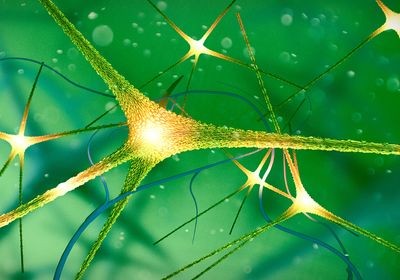ABOVE: Lack of consensus led researchers to explore optimal conditions for culturing primary cortical neurons. Aurélie Stil
When following old laboratory protocols, researchers may feel like Hermione in Harry Potter and Half-Blood Prince.1 Though she meticulously followed the textbook recipe for making a powerful sleeping potion called “Draught of Living Death,” she failed. Much to her surprise and frustration, her friend Harry successfully concocted the potion during his first attempt and received glowing praise from their teacher because he followed an altered, hand-written recipe. Similarly, researchers often modify published protocols to get better results. Whether the adjustments are minor or significant, these “secret recipes” often stay with the researchers or in their laboratory archives. Even if altered protocols get published, the lack of consensus on a method means that a newcomer would have to spend a lot of time troubleshooting to get optimal results.
Take the protocol for culturing cortical neurons, for example. To culture cortical neurons, researchers add cell suspensions of dissociated cortex onto a polylysine (PL)-coated substrate and, once the cortical neurons have attached to it, submerge the cells in appropriate media. Researchers first seeded brain cells onto PL-coated dishes in 1974, and since then both poly-D-lysine (PDL) and poly-L-lysine (PLL)—the two existing forms of PL—have been widely used for neural cultures.2 Yet, no consensus exists for the recipe to prepare the PL solution or the substrate coating procedure. So, maintaining cortical neurons in culture for a prolonged time is still challenging.

Aurélie Stil, a researcher in Jean-François Bouchard’s laboratory at the University of Montreal, faced this problem when she failed to reliably maintain the healthy neuronal cultures that she needed to study axon guidance, axon growth, and synapse formation. To overcome this problem, she teamed up with chemical engineers, and together they came up with a simple PDL coating protocol that reliably enhanced cortical neuron adhesion and maturation in vitro. They recently published their protocol in Frontiers in Cellular Neuroscience.3 In an interview with The Scientist, Stil explained how the new protocol came about and why she decided to publish it.
When did you start optimizing the protocol for culturing primary cortical neurons?
Almost immediately after I started working with neuronal cultures, I was having problems. If I had five plates, maybe one would be good. It was really difficult to do my experiments. I felt that the protocol that I was following needed optimization.
What made you seek help from your chemical engineer colleagues?
After a while, I had enough and wanted to fix the problem. I talked to other researchers who work with primary neuronal cultures and they told me that it was not such a big deal—it was to be expected from primary cultures. However, that was not good enough for me. I tried some other protocols, but had similar subpar results. I hypothesized that a suboptimal coating procedure might be causing this.
It was then that I talked to a few chemical engineers because I thought, with their understanding of electrostatic adhesion, they could help me find an optimal coating protocol. That is how our collaboration began. We would talk and try different things, and eventually we came up with something that worked.
See Also "Defying Dogma: Decentralized Translation in Neurons"
Why did you decide to publish your new protocol?
In the beginning, my chemical engineer colleagues simply wanted to help with my own research, but if we found something interesting, I wanted to publish it. I did not want to keep the recipe for myself. By talking with other scientists at meetings and conferences, I became aware that not sharing results from failed experiments or the adjustments that were necessary to make for an experiment to work is a common problem.
Often, it is up to the graduate student or postdoctoral researcher to figure out these technical problems because previously optimized protocols do not always get published. I do not agree with that practice. When we deviate from a published protocol to get our results, we have to share it with the scientific community.
So, when we saw consistently healthy neuronal cultures with the new method, I got really excited. There has not been an update to the old published protocols, and I hope the protocol we describe in our paper will help many researchers working with cortical neuronal cell cultures.
See Also "Mitochondrial Metabolism Dictates Neurons’ Growth Rate"
How did the neurons grown according to the new protocol measure up?
We observed differences in the neurons that we grew following other published protocols and our own. Cells in our protocol were healthier and formed more elaborate and complex neuronal networks, for example. We found that the coating procedure can influence neuronal properties—it is similar to the differences one sees when harvesting cells from different mouse strains and measuring their electrophysiological properties. For consistency, researchers have to keep the same culture substrate for all experiments.
Do you know if your protocol works similarly on different types of neurons?
Not yet, but we plan on testing if our protocol holds up on different cell types. Now that we have an optimized protocol, it is time to do the actual experiments.
This interview has been condensed and edited for clarity.
References:
- J.K. Rowling. Harry Potter and Half-Blood Prince. Scholastic Inc. 2005.
- Yavin E, Yavin Z. Attachment and culture of dissociated cells from rat embryo cerebral hemispheres on polylysine-coated surface. J Cell Biol. 1974;62(2):540-546.
- Stil A, et al. A simple method for poly-D-lysine coating to enhance adhesion and maturation of primary cortical neuron cultures in vitro. Front Cell Neurosci. 2023;17:1212097.







